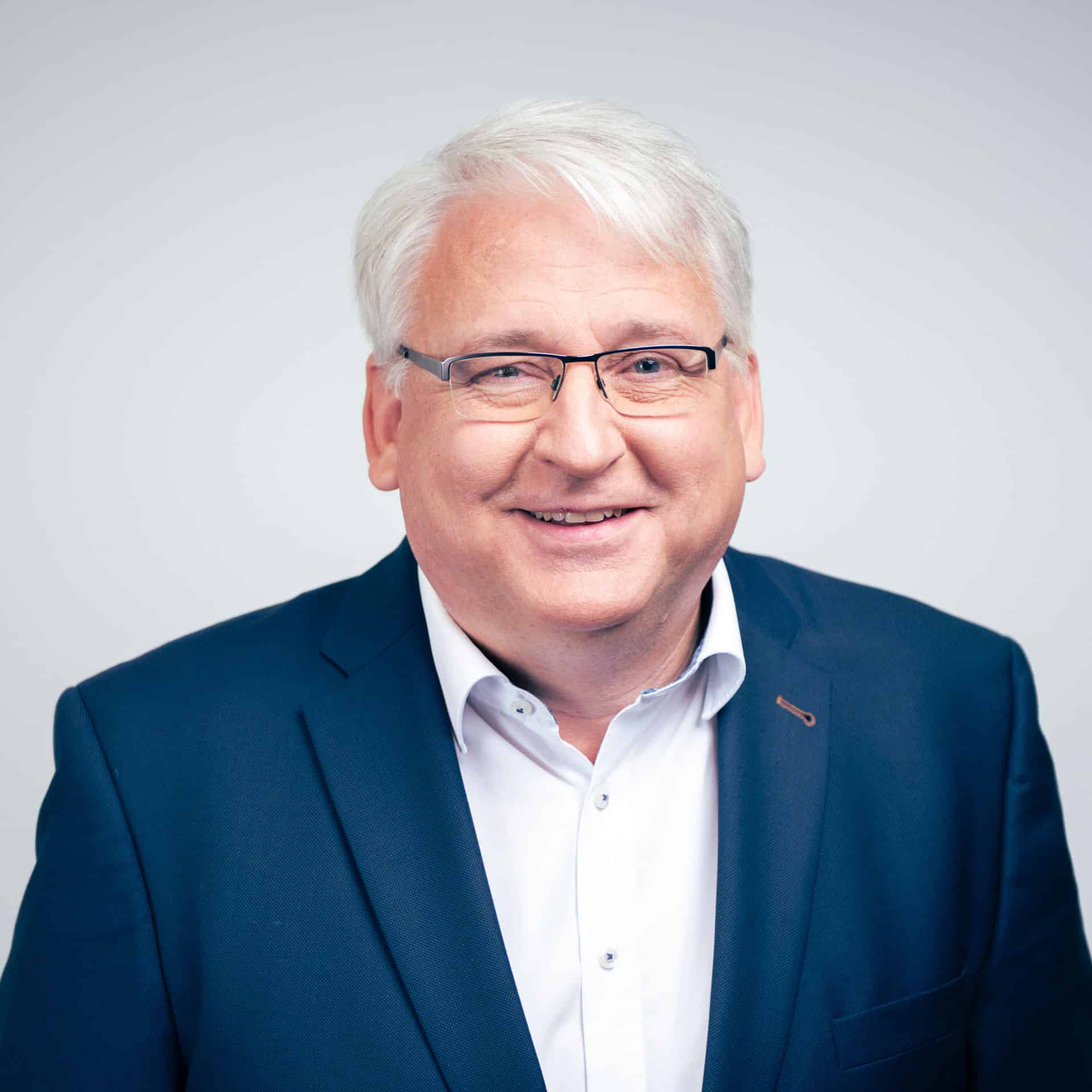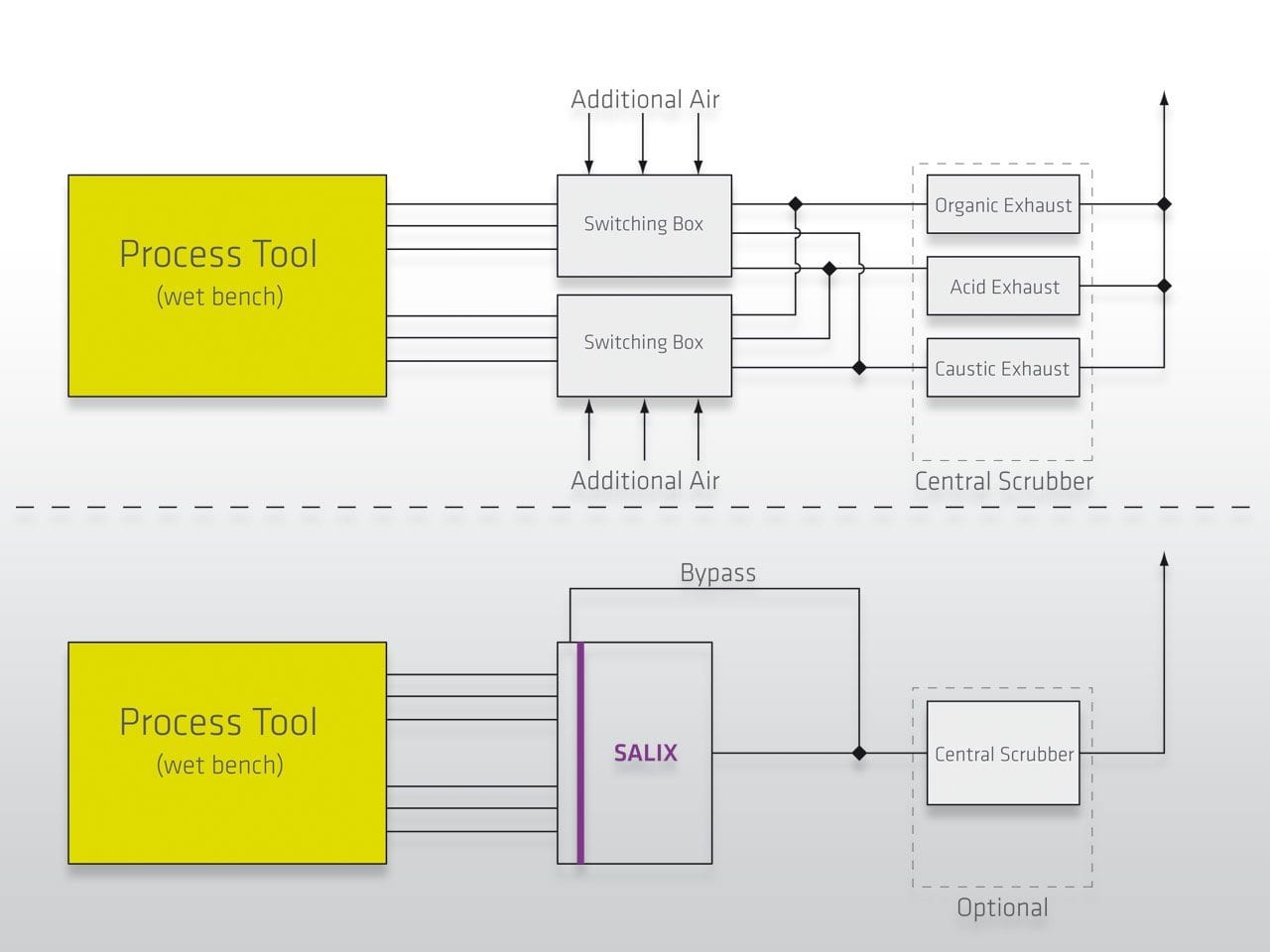New Concept for Point-of-Use Abatement of Harmful Gases in Wet Bench Semiconductor Processes
Switching Boxes replaced by Point-of-Use Systems
In the field of waste gas treatment it is well established practice to treat exhaust air from wet-chemical processes in semiconductor manufacturing with central wet-scrubbers or, if loaded with VOCs, with central thermal oxidizers.
Nevertheless, with single-wafer wet-cleaning tools coming into mass production local wet-scrubbers have advantages.
They replace switching boxes, which direct the exhaust air — depending on actual process conditions — to the different central systems. The challenge in the design of a local scrubber for this application was a trade-off to meet the specific restrictions concerning size, efficiency and pressure drop.
Point-of-Use Concepts offer clear advantages
The point-of-use concept by DAS Environmental Experts was successfully evaluated for this application. The advantages compared to the switching-box concept are smaller and less complex exhaust-piping, smaller load to central treatment systems, reduced loss of clean room air, smaller footprint and higher flexibility for process changes. Low emission concentrations are achieved and salt particle formation from acids and bases is eliminated.
Single Wafer Cleaning in Semiconductor Manufacturing
Many process steps in the semiconductor industry emit harmful waste gases. For chemical vapor deposition or dry etching where very reactive gases are used, so-called point-of-use treatment of waste gases close to the source is common practice. In contrast, for wet chemical processes it is a well-established practice to treat the exhaust air with central wet-scrubbers or, if containing many VOCs, with central thermal oxidizers, both typically located in or on top of the building. Nevertheless, with single wafer cleaning becoming more and more common in mass production, local wet scrubbers have advantages. Technical and commercial reasons have led to the request for an adapted local scrubber solution with limited footprint, which is able to treat in one system all the exhaust air with the cleaning process chemicals. Such a concept is described in this article.
In wet benches, which have been in use for a long time, a carrier with multiple wafers is submerged into a sequence of liquid baths, where each compartment of the wet bench always contains the same type of liquid. The ventilated air from each compartment is directed into one of several exhaust systems, typically classified as acidic, alkaline, VOC and general exhaust.
In contrast, in a single wafer wet-cleaning system single wafers are loaded in a process chamber. A wet-clean tool has multiple process chambers to process several wafers at one time or to perform different process steps in different chambers. At the time of cleaning, the wafers are sprayed with different liquid chemicals in a sequence, which are then removed by spinning the wafer. Besides pure water, typical ingredients are ammonia, sulphuric acid, hydrogen peroxide, ozonized water, hydrofluoric acid or isopropyl alcohol. During the spraying and spinning some liquid evaporates and small liquid droplets can be sucked into the ventilation ducts.
The liquids containing ammonia and liquids containing hydrofluoric acid or sulphuric acid can cause problems due to the formation of salt crystals in the exhaust, where vapors or droplets get into contact with each other. The reaction of ammonia and hydrogen fluoride is reversible (see Equation 1); the formation of ammonium fluoride salt can therefore be suppressed, if the concentration of both gases is kept below an equilibrium value, which can be estimated thermodynamically as
[NH3][HF]< 100 (ppm)² at room temperature.
HF(g) + NH3(g) ↔ NH4F(s)
New Approach for Waste Gas Treatment in Wet Bench Processes
The problem was previously solved by separating the exhaust of each tool chamber into pipes for alkaline, acidic or organic exhaust, as shown in Figure 1. The separation into these three types of exhaust was realized by connecting the exhaust pipes from several chambers of a wet-clean tool to a so-called switching box, where large dimensioned valves directed each exhaust flow from a single chamber into one of the three specific central exhaust pipes, depending on the actual process step in each chamber. Each exhaust pipe was then treated by a specific central scrubber.
Although the switching boxes performed well, several drawbacks forced chip manufacturers to search for a modified solution: to avoid pressure modulations in the exhaust pipes the switching boxes feed air into the dead ends that are temporarily not connected with a process chamber. Each exhaust pipe therefore has to conduct the maximum possible flow for all process chambers at all times. Since the boxes have to be located close to the tool, inside the clean environment, a high volume of costly clean air is lost and has to be replaced. Downstream of each central exhaust pipe, the central scrubber systems are always loaded with the maximum flow of air, requiring a scrubber design capacity that is a multiple of the actual exhaust from the process tools. The area where the auxiliary equipment is installed usually corresponds to the clean room square footage and is therefore limited and densely packed with equipment. Due to the large diameter of pipes and valves, the switching boxes occupy a large footprint. Signals have to be generated to direct the flow from each process exhaust into a suitable central exhaust pipe. However, with a point-of-use wet-scrubber these disadvantages can be overcome.
Generally, wet-scrubbers are well suited to remove soluble gases from a gas flow. Acidic and basic gases (here HF and NH3) can be reduced to low levels by chemical absorption with alkaline or acidic scrubbing liquid (see Equations 2 and 3). For solvents that follow Henry’s Law the lowest possible exhaust concentration post scrubber is limited by the effective concentration in the scrubbing liquid of the final scrubber stage (see Equation 4).
But these theoretical limits require that the scrubber is large enough, specifically, the residence time of the gas is long enough to get the gas and liquid phase into equilibrium, and the flow of liquid is high enough so that concentrations in the liquid remain relatively stable along the scrubber column. The challenge in the design of the SALIX was a trade-off to meet the specific restrictions concerning size, efficiency and pressure drop.
HF + OH– ↔ F– + H2O (2)
NH3 + H3O+ ↔ NH4+ + H2O (3)
kH = p / caq (4)
where caq is the concentration in the liquid phase
p is the partial pressure in the gas phase
Figure 2 shows the schematic diagram of a new point-of-use wet-scrubber solution called SALIX. All process chambers from one process tool are connected into one wet-scrubber, which is connected to only one central exhaust pipe. An additional feature, requested by customers is a bypass line around the scrubber to keep the tool ventilated during scrubber maintenance or in case of failure. Located directly at the entrance of the exhaust pipes into the wet-scrubber are spray nozzles that initially reduce the concentration of soluble gases before the different exhaust flows get mixed. The gas then flows through two packed scrubbing stages, which can be operated with different scrubbing liquids. At the end of each scrubber stage a demister removes droplets from the gas flow. The pressure in the system is controlled and kept constant by a fan with an electronic frequency converter. The gas can bypass the two scrubbing stages in case of failure or maintenance.
Operating Principle of the Point-of-Use-Solution SALIX
In order to accommodate limitations in footprint and height the scrubber stages have to be as compact as possible. A typical column construction with several scrubbing units stacked on top of each other is therefore not suitable. Two rectangular packed counter-flow stages are arranged side-by-side inside of one frame. Because the gas transfer into the liquid phase depends on the contacted liquid surface, both stages are designed as packed columns. The selection of the tight packing material was a critical point in the design, as smaller packing material generally increases the contact surface, but also leads to a higher pressure drop across the packing. Since the scrubber height is necessarily fixed, packing material must have a specific surface area as large as possible; yet enough open volume between the individual units of packing material is required so that the exhaust fan can still constantly compensate for the pressure difference across the packing. Narrow areas and bends within the gas flow path and the demisters contribute to the pressure drop along the system. Because both stages are counter-flow columns, the gas has to flow a complex path from the entrance on the side of the scrubber to the bottom of the first stage and again from the top of the first stage to the bottom of the second stage and out of the side of the scrubber. The potential for pressure drop in the system needed to be mitigated for the compact design of the SALIX.
New Scrubber SALIX for Waste Gas Treatment in Wet Bench Processes
The design of the SALIX allows different inlet configurations with up to 12 separate 6″ inlets with a total flow of 1.000 — 4.000 m³/h. The footprint of the scrubber is only 4 m² (less than 40 % of the older installations) at a height of 2.04 m without the bypass; it measures 2.57 m including the bypass option. With the frequency-controlled fan a pressure stability of +/-10Pa during process is achieved. Total exhaust flow and consumption of clean room air is about one third of the older installations. For process tools with fewer chambers or less total exhaust flow a smaller version was designed, with only a 1‑stage scrubber. Future enhancements will concentrate on further improvement of pressure stability and the optimization of media consumption.
The SALIX system was designed, built, and certification obtained according to the SEMI S2 safety standard within 6 months. A bypass function was added by customer request. The wet-scrubber was evaluated at a customer site, where it was connected to 12 chambers from a single-wafer process tool. There pressure stability at the scrubber inlet during normal operation and in case of switching to bypass was optimized and qualified. Inlet and outlet concentrations were measured at the process line using FTIR technology. As a result, the system was qualified by the customer for use at this company’s single wafer wet-clean processes without any need for further modification.
Conclusion
The point-of-use wet-scrubber concept for the treatment of the exhaust from single-wafer wet-clean tools was realized with the design of the SALIX system and successfully evaluated at a fab. Low emission concentrations were achieved and salt particle formation from acids and bases eliminated. The advantages over the older system are: smaller and less complex exhaust-piping; smaller load to central scrubber systems; higher flexibility for process changes; reduced loss of clean room air, and smaller footprint.

Your Contact for Waste Gas Treatment in the Solar Industry:
Dr. Guy Davies
Director Business Development Global




